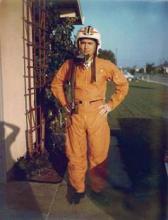One of the first things one may notice about Dr. Roy D. Altman are his neckties. They are hand painted by his wife Linda and have been his trademark since the 1970s.
At first glance, you might think you recognize the silly dog or other fanciful creatures included in their design. But rest assured that any resemblance to a copyrighted character is only in your imagination.
Dr. Altman’s adoption of hand-painted ties was born of the sensible desire to be recognizable in a busy world: "I was at an ASIM national meeting when a reporter stopped me in the hall to ask where the rheumatology meetings were. When I asked him how he knew me, he answered that he recognized me because of my painted tie. Since then, the ties have become my trademark, and I almost never wear anything else," Dr. Altman said in an interview.
He did not need the ties to be memorable. Dr. Altman stands out in the specialty of rheumatology because of the strength of his career as a teacher, researcher, clinician, and editor. He was the chief of rheumatology and immunology at the University of Miami until 2003 when he traded the swelter of Miami for the Pacific breezes of UCLA, where he is professor of medicine in the division of rheumatology and immunology at the University of California, Los Angeles.
While in Miami, Dr. Altman had a second academic appointment as professor of orthopedics. In addition, he served as the clinical director of the geriatric research, education, and clinical center (GRECC), and chief of the arthritis section in the division of medicine at the Miami Veterans Affairs Medical Center.
But before all of that, before the 16-year stint as editor of Osteoarthritis & Cartilage and 30 years as coeditor with Dr. Norman Gottlieb of Seminars in Arthritis and Rheumatism, before the awards and honors, there were the formative experiences.
It was Dr. Altman’s father’s contact dermatitis that made it necessary for him to leave his job with a dye manufacturer and uproot his young family to follow his own snowbird father to Miami. There as a youngster Dr. Altman worked around the apartment house his grandfather owned and learned maintenance in the form of plumbing, painting, and electrical repair. As he got a bit older, Dr. Altman helped out at the hotel his own parents owned. In those jobs he became skilled at "dealing with elderly crotchety people." That must have come in handy later.
After graduating from Miami Beach high school and Michigan State University, East Lansing, Dr. Altman attended and graduated from the University of Miami School of medicine, where he also did his internship, residency, and fellowship in rheumatology.
Military service interrupted his training. Between his internship and residency, Dr. Altman served as a lieutenant in the U.S. Navy active duty reserve. He began his service as a general medical officer on a World War II–era aircraft carrier delegated to transporting President John F. Kennedy’s helicopters. After the president’s assassination, the ship was decommissioned and Dr. Altman was stationed at Naval Air Station Point Mugu in Oxnard, Calif., which was home of the U.S. Navy Pacific missile range. There he took care of sailors and officers. From that experience, Dr. Altman said that he took away a few life lessons, such as what a pleasant way of the life the military could provide, as long as there was no war. His own time of service coincided with the Vietnam War, which he somehow missed "by a week."
He also appreciated the "the comradery of the military" and experienced compassion for those who were injured. Perhaps not a war wound, the most interesting case he treated while with the navy was a captain with "a toothpick from a martini lodged in his cecum." The most difficult case involved "dealing with appendicitis at sea in a hurricane with no surgeon and unable to arrange an air evacuation." Among the rheumatologic cases he saw were men with calcific bursitis, reactive arthritis, and arthritis due to Neisseria gonorrhea.
Dr. Altman settled on rheumatology as a specialty in part because he enjoyed the contact with patients. In addition, the complexity of the diseases was a challenge he could not refuse. And no small part of the credit for moving him into rheumatology goes to his mentors.
Often a person reaches their career path through the intervention of a number of mentors. Dr. Altman names his greatest mentors as being: Dr. Harvey Brown, whom he called an "incredible clinician, extremely knowledgeable." Also on Dr. Altman’s personal pantheon was his research mentor, Dr. David Howell, who was internationally known for his work on osteoarthritis. "He brought me into the field." Dr. Altman credits his interest in intra-articular therapy and systemic lupus erythematosus to Dr. Alonso Portuondo, who, before he fled Cuba, cared for most of the SLE patients there.



